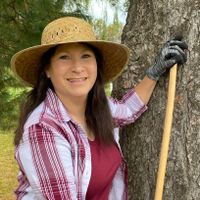Tough As Clay

Long before I lived here, glaciers spread across the land. These geological events shaped the surface of the earth and deposited various types of rock and sediment. During the roughly 12,000 years since the last glacier, water and wind has eroded much of the finer soil from my property. I was left with clay and growing vegetables in heavy clay soil is not fun.
Properties of Clay Soil
Like most new homeowners, I was excited to make the place our own. This included fixing up the inside of the home, redoing the landscaping around the house, and of course, planting a vegetable garden. The last turned out to be the hardest.
After all, who thinks of taking a shovel and digging into the yard when looking at houses? Little did I know that under the thin covering of grass was approximately 2 feet (61 cm.) of red clay. Dig deeper and it turns to gray clay, much like what I played with in kindergarten.
Thus, during my first year growing a vegetable garden, I learned two very important lessons about clay: dry clay is rock hard, and wet clay is sticky. I broke many tools my first years of gardening and wet clay ruined just as many shoes.
The size and shape of the individual clay particles are responsible for these clay soil properties. Unlike sand which is angular, or silt which is round, clay particles are much smaller and flat. This gives clay the ability to be cohesive and stick to itself. It also allows clay to be adhesive and stick to other things.
Clay Soil in the Vegetable Garden
Growing mediums which contain mostly clay particles are often called heavy soils. Clay drains poorly in wet weather and cracks when dry. Although clay soils contain the nutrients plants need, there is little air space between the clay particles for the root system to expand and reach the available nutrients.
For me, this meant my vegetable plants did not grow to their full potential or produce expected yields. Clay soil doesn't break up to a fine powder but stays chunky when tilled. This decreased the germination rate of the carrots, cucumbers, and cantaloupe seeds I planted.
Sign up for the Gardening Know How newsletter today and receive a free copy of our e-book "How to Grow Delicious Tomatoes".
Clay is also slow to absorb water, thus an inappropriately timed heavy rain would sometimes wash my seeds away. Poor drainage resulted in losing plants to root rot. However, the worst issue I faced was weeding. It was impossible to pull weeds out by the roots, so they quickly re-grew and overtook the garden.
I knew if I wanted to successfully grow vegetables in the future, I would need to do something. As a new homeowner with a mortgage to pay, a raised bed system was too expensive to install. This meant amending the soil that was already in the garden.
How to Amend Clay Soil
I have to admit, I was a young and naive gardener back then. Yet, I managed to get it right. Amending clay soil is an easy process of slowly adding organic material over the course of many years. I used the organic waste from my own property, including horse manure with wood shavings, grass clippings, and fall leaves.
These materials must be added slowly over a period of time to prevent nitrogen depletion. This occurs when the microorganisms in the soil use nitrogen to break down carbon-rich materials. Just as in a compost pile, the nitrogen-rich or “green” materials included the horse manure and grass.
These must be balanced with “brown” carbon-rich material such as the wood shavings and leaves. When the microorganisms die, they release the nitrogen back into the soil. By adding organic materials slowly, the nitrogen released will equal or exceed the nitrogen being consumed.
It's now thirty plus years later. The nutrient and water holding clay particles are still present in my garden soil, but their ratio to organic material has changed significantly. I no longer see hard, cracked soil. Instead, it breaks apart easily and creates a bed of fine dirt for starting seeds. The drainage has improved, yet it retains sufficient moisture during dry spells. My plants grow to full size and produce bushels of produce. Most importantly, I can easily pull those darn weeds!

Laura Miller has been gardening all her life. Holding a degree in Biology, Nutrition, and Agriculture, Laura's area of expertise is vegetables, herbs, and all things edible. She lives in Ohio.